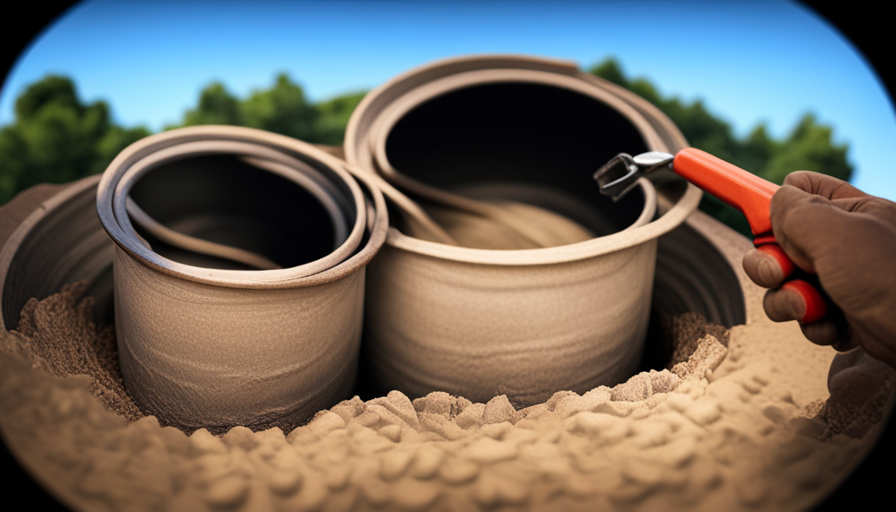I have always been fascinated by the idea of living off the grid and fully embracing nature. However, the lack of proper sanitation facilities while camping was always a major drawback for me. That’s when I stumbled upon the idea of building a septic tank for my camper. It truly revolutionized my outdoor adventures!
In this article, I will guide you through the process of making your own septic tank for a camper. We will cover everything from understanding the basics of a septic system to choosing the right location, digging the hole, installing the tank, and connecting the pipes. I will also walk you through creating a drainage field and provide tips on how to maintain and clean your septic tank regularly.
So, if you’re ready to take your camping experience to the next level and enjoy the convenience of a portable septic system, let’s dive right in!
Key Takeaways
- Regular maintenance and cleaning of the septic tank are crucial for longevity and functionality.
- Proper installation and location of the septic tank are important to avoid issues with odors and overwhelming odors.
- A ventilation system and proper vent pipes are necessary to prevent the buildup of harmful gases and direct odors away from the camper.
- Adding a drainage field with proper design and construction is essential for septic tank maintenance in a camper.
Understand the Basics of a Septic System
So, you’re ready to learn the nitty-gritty about septic systems, huh? Let’s dive right in and understand the basics of how this essential system works for your camper.
A septic system is an underground wastewater treatment system that is commonly used in areas where there’s no access to a municipal sewer system. It consists of two main components: the septic tank and the drainfield.
The septic tank is responsible for separating solids from liquids and breaking down organic matter through a process called anaerobic digestion. On the other hand, the drainfield is where the treated wastewater is distributed into the soil for further filtration and purification.
To ensure the proper functioning of your septic system, regular septic system maintenance is crucial. This includes periodic pumping of the septic tank to remove accumulated solids and prevent clogging. Additionally, septic tank installation should be done correctly to avoid any potential issues in the future. This involves determining the appropriate size of the septic tank based on the number of occupants in your camper and complying with local regulations.
Now that you understand the basics of a septic system, let’s move on to gathering the necessary materials and tools for building your own septic tank for a camper.
Gather the Necessary Materials and Tools
First, you’ll need to gather all the essential materials and tools for this project, like a container, hoses, and fittings, while keeping in mind that this journey is akin to setting sail on a new adventure. Choosing the right materials is crucial to ensure the durability and effectiveness of your homemade septic tank.
Look for a sturdy container that can hold a sufficient amount of waste and withstand the rigors of travel. Additionally, select hoses and fittings that are compatible with the container and can securely connect the various components of your system.
Understanding septic tank maintenance is equally important. Research the best ways to keep your tank clean and functioning properly while on the road. This may include using natural additives to break down waste and regularly emptying the tank at designated disposal sites. Proper maintenance will prevent odors, blockages, and other issues that can arise from a poorly maintained septic system.
Now that you have gathered the necessary materials and tools, it’s time to choose the right location for your septic tank.
Choose the Right Location for Your Septic Tank
Selecting the perfect spot for your homemade septic tank will ensure a worry-free journey and keep your adventure flowing smoothly. When choosing the right location for your septic tank, there are important environmental considerations and potential hazards that need to be taken into account.
First and foremost, you should avoid placing the tank near any water sources such as rivers, lakes, or wells, as it can contaminate the water supply. Additionally, it is crucial to steer clear of any underground utilities such as gas lines or electrical cables to prevent accidents and damage to the infrastructure.
Another factor to consider is the proximity to your camper. You want the septic tank to be easily accessible for waste disposal, but not so close that the odors become overwhelming. It’s recommended to place the septic tank at least 10 feet away from your camper to strike the right balance.
Selecting the appropriate location for your septic tank involves careful consideration of environmental factors and potential hazards. By avoiding water sources and underground utilities, and finding a balance between accessibility and odor control, you can ensure a safe and efficient septic system for your camper.
Now, let’s move on to the next step and dig a hole for the tank.
Dig a Hole for the Tank
Find the perfect spot in your chosen location and prepare to dig a hole that will be the foundation for your efficient waste management system. Before beginning, it’s crucial to determine the appropriate hole size and tank depth for your septic tank.
The hole size should be sufficient to accommodate the tank and allow for proper installation and maintenance. Typically, a hole with dimensions of about 6 feet long, 4 feet wide, and 5 feet deep is suitable for a standard-sized septic tank.
When digging the hole, it’s essential to consider the local regulations and make sure you comply with any required setbacks from property lines, wells, or water bodies. Use a shovel or an excavator to carefully excavate the hole, ensuring that the walls are vertical and the bottom is level. Take caution not to damage any existing utility lines or structures during the excavation process.
Once the hole is dug to the appropriate dimensions, you can move on to installing the tank and connecting the pipes. This next step is crucial for the proper functioning of your septic system, as it allows for the collection and treatment of wastewater.
Install the Tank and Connect the Pipes
After carefully excavating the hole to the appropriate dimensions, it’s time to proceed with the installation of the septic tank and the crucial task of connecting the necessary pipes for efficient wastewater collection and treatment.
To connect the tank to the camper, a comprehensive understanding of the plumbing system is essential. Firstly, it is important to determine the optimal location for the tank, ensuring accessibility for maintenance and efficient drainage. Once the tank is securely in place, the inlet pipe should be connected to the camper’s wastewater outlet, while the outlet pipe should be directed towards the drain field.
To visually illustrate the process, refer to the following table:
| Pipe Type | Purpose | Connection Method |
|---|---|---|
| PVC | Inlet | Slip joint |
| PVC | Outlet | Cement |
| PVC | Vent | Coupling |
| PVC | Cleanout | Threaded cap |
Troubleshooting common septic tank issues is crucial for successful installation. Problems such as clogging, leaks, or foul odors can arise. To address these issues, regular inspection and maintenance are necessary. If a clog occurs, it can often be cleared by using a plumber’s snake or employing a high-pressure water jet. Leaks can be resolved by tightening connections or replacing damaged pipes. To eliminate unpleasant odors, adding bacteria-based treatments to the tank can help break down waste more effectively.
Connecting the septic tank to the camper involves careful planning and execution. Once the installation is complete, it is crucial to create a ventilation system to ensure proper airflow.
Create a Ventilation System
Creating a ventilation system is an essential step in the installation process, as it helps to maintain proper airflow and prevent the buildup of harmful gases, which can pose health risks. Interestingly, studies have shown that a well-designed ventilation system can reduce odors and improve overall air quality by up to 80%.
To ensure effective ventilation in your camper’s septic tank, follow these steps:
-
Install a fan: A ventilation fan is crucial for drawing out foul odors and maintaining a constant flow of fresh air. Choose a fan that’s specifically designed for septic systems and install it in a location that allows for optimal air circulation.
-
Use appropriate vent pipes: Proper vent pipes are essential for directing odors away from the camper. Install vent pipes that’re the correct size and length, ensuring they’re properly sealed to prevent air leaks.
-
Prevent odors: In addition to the ventilation fan and vent pipes, consider using odor-reducing products such as activated charcoal filters or bio-additives. These can effectively neutralize odors and improve the overall smell of your camper.
By installing a well-designed ventilation system, you can effectively prevent odors and maintain a pleasant living environment in your camper.
In the next section, we’ll discuss how to add a drainage field to complete the septic tank installation process.
Add a Drainage Field
To ensure a healthy and pleasant environment in your camper, you’ll be amazed at how adding a drainage field can transform your outdoor living space. A well-designed drainage system is essential for proper septic tank maintenance.
When designing your drainage field, it’s important to consider the size and composition of the soil, as well as the slope of the land. The goal is to create a system that allows the liquid waste from your septic tank to be evenly distributed and absorbed into the soil.
Start by excavating a trench that’s wide and deep enough to accommodate the drainpipes. Next, lay down a layer of gravel at the bottom of the trench to promote proper drainage. Then, place perforated drainpipes on top of the gravel, ensuring they’re sloped to allow for the flow of liquid waste. Cover the drainpipes with another layer of gravel, followed by a layer of geotextile fabric to prevent soil from clogging the system.
Backfill the trench with soil, making sure to tamp it down firmly. Regular maintenance and cleaning of your septic tank are crucial to its longevity and functionality. By following a regular maintenance schedule and implementing proper cleaning techniques, you can ensure that your septic tank continues to operate efficiently.
Transitioning into the next section, it’s important to maintain and clean your septic tank regularly to avoid any potential issues down the line.
Maintain and Clean Your Septic Tank Regularly
To ensure the proper functioning of your septic tank system, it’s essential to maintain and clean it regularly. Neglecting this crucial step can lead to costly repairs and potential health hazards.
Septic tank maintenance involves a series of tasks that help keep the system running efficiently. First and foremost, regular pumping is necessary to remove accumulated solid waste and sludge from the tank. The frequency of pumping depends on the size of your tank and the number of people using it. Typically, it’s recommended to pump the tank every three to five years.
In addition to pumping, inspecting the tank for any signs of damage or leaks is vital. This includes checking the inlet and outlet pipes, as well as the tank walls, for any cracks or deterioration. Repairing any issues promptly can prevent further damage and prolong the lifespan of your septic tank.
Properly maintaining your septic tank also involves being mindful of what goes down the drains. Avoid flushing non-biodegradable items, chemicals, or excessive amounts of grease, as these can clog the system and disrupt the bacterial balance.
Lastly, consider using septic tank additives or treatments to enhance the bacterial activity and breakdown of waste in your tank. These products can help maintain a healthy septic system.
By regularly maintaining and cleaning your septic tank, you can ensure its longevity and prevent costly repairs. However, it’s crucial to follow local regulations and guidelines to ensure the proper disposal of waste from your camper.
Follow Local Regulations and Guidelines
Following local regulations and guidelines is like navigating the winding path to a well-maintained oasis, ensuring the proper disposal of waste from your home on wheels. It is crucial to adhere to these regulations not only to avoid potential health risks associated with improper septic tank disposal but also to maintain the longevity and efficiency of your camper septic tank.
Regular inspection and maintenance of your camper septic tank are of utmost importance. By doing so, you can identify any potential issues early on and prevent costly repairs or replacements. Moreover, regular maintenance ensures that your septic tank operates at its optimal capacity, preventing any blockages or backups that could disrupt your travels.
To help you keep track of your maintenance tasks, I have created a table below outlining the key components and recommended maintenance schedule for your camper septic tank:
| Component | Maintenance Frequency |
|---|---|
| Tank | Every 3-5 years |
| Drainfield | Annual inspection and pumping |
| Inlet and Outlet | Monthly inspection |
| Vent Pipe | Quarterly inspection |
| Baffle | Bi-annual inspection and cleaning |
By following these guidelines and regularly inspecting and maintaining your camper septic tank, you can ensure its proper functioning and minimize the risk of any issues. With a well-maintained septic system, you can enjoy the convenience of your portable septic system without any worries.
Enjoy the Convenience of Your Portable Septic System
Now you can fully embrace the ease and convenience of your mobile sewage system. Having a portable septic tank for your camper comes with a range of benefits that make your camping experience more enjoyable and hassle-free. Here are four key advantages of using a portable septic tank:
-
Portability: One of the greatest benefits of a portable septic tank is its mobility. You can easily transport it to different camping sites without any hassle. This gives you the freedom to explore various locations and enjoy the beauty of nature without worrying about sewage disposal.
-
Easy Maintenance: Portable septic tanks are designed for easy maintenance. They usually have built-in features such as removable waste containers and easy-to-clean surfaces. Regular maintenance includes emptying and cleaning the tank, checking for leaks or damages, and ensuring proper ventilation.
-
Odor Control: Unlike traditional sewage systems, portable septic tanks are equipped with odor control mechanisms. They use special chemicals and filters to minimize unpleasant smells, ensuring a more pleasant camping experience for you and your fellow campers.
-
Environmental Friendly: Portable septic tanks are designed to be environmentally friendly. They have features like leak-proof seals and proper waste disposal methods to prevent any harm to the environment. By using a portable septic tank, you can enjoy the convenience of a sewage system while minimizing your impact on nature.
To make the most out of your portable septic tank, it’s important to follow some maintenance tips:
- Regularly empty and clean the tank to prevent any buildup or clogs.
- Use biodegradable toilet paper and avoid flushing any non-biodegradable items.
- Properly dispose of waste at designated dumping stations.
- Follow the manufacturer’s guidelines for maintenance and usage to ensure optimal performance.
By following these maintenance tips and taking advantage of the benefits offered by a portable septic tank, you can enjoy a convenient and worry-free camping experience.
Frequently Asked Questions
How often do I need to clean and maintain my septic tank for a camper?
Cleaning and maintaining a septic tank for a camper is crucial to ensure proper functioning and prevent unpleasant odors. Cleaning frequency depends on usage, but on average, it’s recommended to clean it every 3-4 months.
Regular maintenance tips include using biodegradable RV toilet paper, avoiding excessive use of chemicals, and periodically flushing the tank with water. Additionally, inspecting for leaks and ensuring proper ventilation are essential for optimal septic tank performance.
Can I use any type of toilet paper in my camper septic tank?
Yes, it’s important to use the right type of toilet paper in a camper septic tank. Toilet paper alternatives, such as biodegradable or RV-specific toilet paper, are recommended. These alternatives break down easily and reduce the risk of clogs or damage to the septic tank system. Best practices for waste disposal include using minimal amounts of toilet paper and ensuring it’s thoroughly dissolved before flushing. Proper waste management is crucial for the efficient and effective operation of a camper septic tank.
Can I use chemicals to help break down waste in my camper septic tank?
Using chemicals in a camper septic tank can have both pros and cons. On one hand, they can help break down waste and control odors. For example, I used a biodegradable enzyme-based product that effectively broke down waste in my camper septic tank, reducing the need for frequent emptying.
However, it’s important to note that some chemicals can harm the tank’s beneficial bacteria and disrupt the natural breakdown process. Additionally, certain chemicals may be harmful to the environment if not used properly.
How do I know if my camper septic system is functioning properly?
To troubleshoot a camper septic system, there are a few key indicators to look out for. Firstly, check for any leaks or foul odors around the tank or plumbing connections. Ensure that the tank is properly sealed and that all valves and seals are in good condition.
Regularly inspect the drain lines for any clogs or blockages. To prevent septic system issues, avoid putting grease, oil, or non-biodegradable items down the drain. Also, use septic-safe toilet paper and regularly treat the tank with enzyme-based additives to promote healthy bacterial growth.
Are there any specific regulations or guidelines I need to follow when using a septic tank for a camper in different states?
When using a septic tank for a camper in different states, it’s crucial to adhere to specific regulations and guidelines. Each state may have its own set of requirements and restrictions regarding the use of septic tanks.
These regulations can vary significantly, so it’s important to research and understand the specific rules in the state where you plan to use the septic tank. Failure to comply with these regulations may result in penalties or fines.
Can I Use the Septic Tank I Made for My Camper During Winterization with Antifreeze?
Yes, you can use the septic tank you made for your camper during winterization with antifreeze. It is essential to properly winterize camper antifreeze to prevent any damage to the plumbing system and tanks during cold weather. Remember to follow manufacturer’s instructions for using antifreeze in your camper’s plumbing system.
Conclusion
In conclusion, building a septic tank for a camper can provide a convenient and efficient waste management solution. By understanding the basics of a septic system and following the proper guidelines, you can create a portable septic system that meets your needs.
It’s interesting to note that, according to a study conducted by the Environmental Protection Agency, regular pumping and maintenance of septic tanks can extend their lifespan by up to 20 years. This statistic emphasizes the importance of regular maintenance to ensure the longevity and effectiveness of your septic tank.











